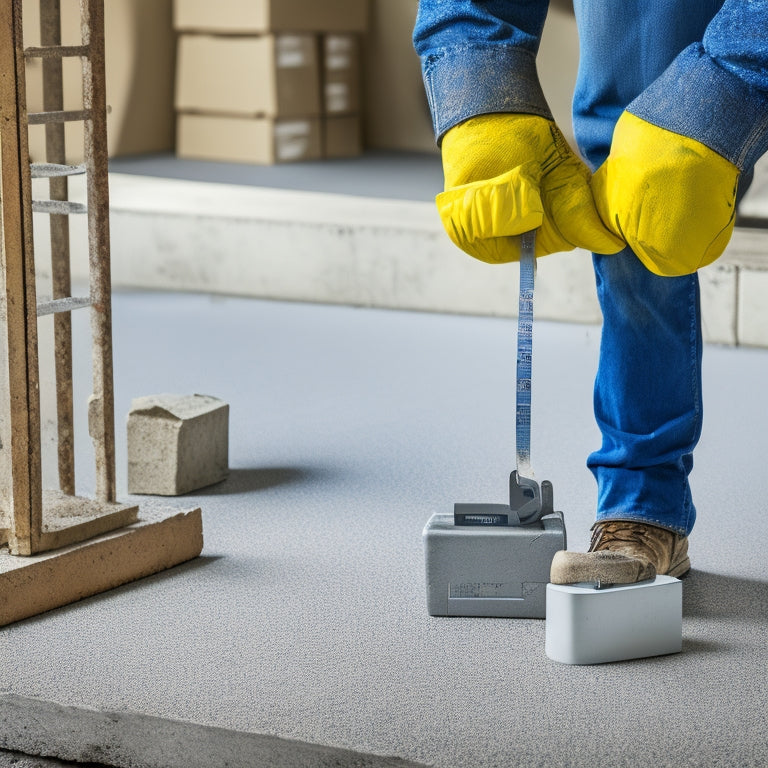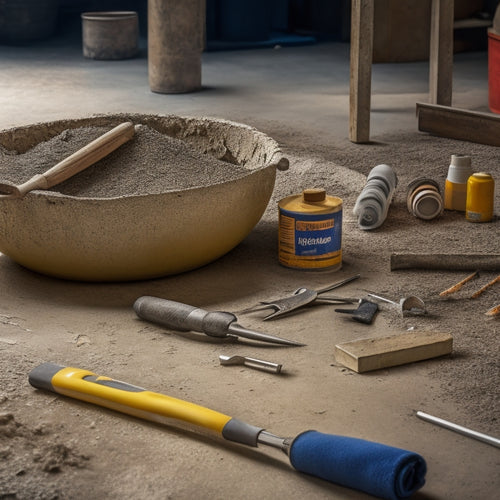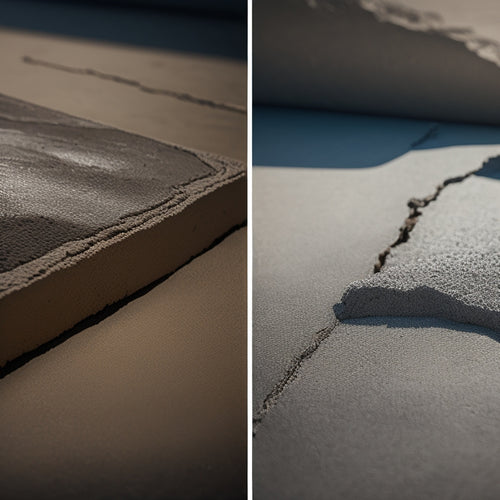
Accurate Width Measurement Tools for Concrete Blocks
Share
When measuring concrete block widths, you need a tool that provides reliable and accurate results to guarantee structural integrity. Digital calipers, laser distance measuring tools, and measuring blocks with micrometers offer high accuracy and ease of use. Straight edge rulers, precision tapes, and width gauges are also available for specific measurement needs. Each tool has its features and benefits, and choosing the right one depends on your project requirements. By selecting the appropriate tool, you can minimize errors and guarantee compliance with construction standards. Now, explore the unique advantages of each tool to find the best fit for your project.
Key Takeaways
• Digital calipers provide accurate and reliable width readings for concrete blocks, minimizing human error and ensuring trustworthy measurements.
• Laser distance measuring tools enable quick and precise distance calculations, facilitating instant on-site measurements and reducing time and errors.
• Measuring blocks with micrometers offer precision with accuracy ranging from 0.001 mm to 0.01 mm, ideal for ensuring structural integrity in construction.
• Manual measurement tools like straight edge rulers, precision tapes, and width gauges provide reliable means of measuring concrete block widths accurately.
• Accurate width measurement tools are essential for meeting concrete block width measurement standards and ensuring the structural integrity of concrete installations.
Digital Calipers for Precise Width
When measuring the width of concrete blocks, you'll find that digital calipers provide an accurate and reliable method for achieving precise width readings. These precision instruments offer several benefits, including high accuracy and ease of use. With digital calipers, you can quickly and easily take precise measurements, eliminating the need for manual calculations or conversions.
Compared to traditional measuring tools like tape measures or rulers, digital calipers provide more accurate and consistent results. They're also less prone to human error, ensuring that your measurements are reliable and trustworthy.
Additionally, digital calipers often feature advanced functions, such as unit conversions, data storage, and statistical analysis, making them a valuable asset for professionals and DIYers alike.
In terms of measuring tool comparisons, digital calipers stand out for their precision and versatility. They're ideal for measuring the width of concrete blocks, as well as other materials, such as wood, metal, or plastic.
Laser Distance Measuring Tools
When you're measuring concrete block widths, you'll find that laser distance measuring tools offer several advantages.
You'll be able to calculate precise distances quickly, which allows you to take more measurements in less time.
Additionally, these tools often come equipped with enhanced accuracy features that help you achieve reliable results on-site.
Precise Distance Calculations
You can achieve precise distance calculations with laser distance measuring tools, which use laser beams to measure distances with high accuracy and speed.
These tools are ideal for width measurement techniques that require precision, as they can provide exact measurements in a matter of seconds. With laser distance measuring tools, you can guarantee distance measurement accuracy, which is vital in concrete block construction where even slight variations can affect the structural integrity of the building.
To calculate distances, laser distance measuring tools emit a laser beam that reflects off a target and returns to the device. The tool then calculates the distance based on the time-of-flight principle, providing accurate measurements up to a certain range.
This technology allows you to measure distances quickly and efficiently, saving you time and effort on the job site. By using laser distance measuring tools, you can guarantee that your width measurements are accurate, reliable, and repeatable, giving you confidence in your construction projects.
Quick On-Site Measurements
Laser distance measuring tools enable instant on-site measurements, allowing contractors to swiftly assess concrete block widths and make informed decisions about construction progress.
With these tools, you can overcome traditional measurement challenges, such as manual calculations and tape measures, which can be time-consuming and prone to errors. On-site techniques like laser measurement provide accurate and reliable data, reducing the risk of mistakes and rework.
Using laser distance measuring tools, you can quickly capture precise width measurements of concrete blocks, even in hard-to-reach areas. These tools utilize laser technology to calculate distances with high accuracy, making them ideal for on-site applications.
With the ability to store multiple measurements, you can track changes in concrete block widths over time, ensuring that your construction project meets the required specifications.
Enhanced Accuracy Features
Beyond their ability to provide quick on-site measurements, laser distance measuring tools offer advanced features that further enhance their accuracy and reliability.
As you use these tools, you'll appreciate the enhanced calibration that guarantees precise measurements even in complex environments. The advanced measurement technology integrated into these tools allows for accurate readings, even when dealing with irregularly shaped concrete blocks.
Here are some key features that contribute to the enhanced accuracy of laser distance measuring tools:
-
Multi-axis levelling: Guarantees that measurements are taken from a level plane, reducing errors caused by uneven surfaces.
-
Automatic temperature compensation: Adjusts measurements to account for temperature fluctuations, which can affect measurement accuracy.
-
Advanced algorithms: Process data to minimize errors and provide reliable readings, even in challenging conditions.
- Real-time data processing: Provides instant feedback, allowing you to quickly identify and correct any measurement errors.
Straight Edge Rulers for Blocks
Straight edge rulers designed specifically for concrete blocks provide a reliable means of measuring their width with precision. You can trust these tools to deliver accurate readings, making them essential for construction projects where exact measurements are vital.
When choosing a straight edge ruler, consider the material and application. Here's a breakdown of popular options:
| Ruler Material | Straight Edge Applications | Accuracy Level |
|---|---|---|
| Stainless Steel | General construction, rough framing | ±0.5 mm |
| Fiberglass | Precise layout, finish carpentry | ±0.2 mm |
| Aluminum | Heavy-duty construction, site measurement | ±1.0 mm |
| Carbon Fiber | High-precision measurement, quality control | ±0.1 mm |
| Wooden | DIY projects, rough estimates | ±2.0 mm |
These rulers are designed to withstand the demands of construction sites, with durable materials and robust constructions. By selecting the right straight edge ruler for your specific needs, you'll guarantee accurate width measurements and avoid costly mistakes.
Precision Tapes for Cinder Blocks
When measuring the thickness of cinder blocks, you'll need a precision tape that can provide accurate readings.
To get reliable measurements, you'll want to guarantee you're using the tape correctly, which involves understanding how to read the tape accurately.
Measuring Block Thickness
You can guarantee accurate thickness measurements for cinder blocks by using precision tapes specifically designed for this purpose. These tapes are engineered to provide precise readings, making certain that your block density calculations are reliable and consistent with industry measurement standards.
When measuring block thickness, it's vital to take into account the following factors:
-
Material variation: Cinder blocks can vary in density and composition, affecting their thickness.
-
Environmental conditions: Temperature and humidity can impact the block's dimensions.
-
Measurement technique: Improperly positioning the tape or applying uneven pressure can lead to inaccurate readings.
- Tape calibration: Confirm your precision tape is calibrated regularly to maintain its accuracy.
Reading Tape Accurately
To guarantee accurate readings, hold the precision tape firmly against the block's surface, keeping it parallel to the edges and avoiding any twisting or angling. This assures the tape lies flat, providing a precise measurement. When taking readings, make sure to keep your eyes level with the tape's markings to avoid parallax errors.
It's essential to choose a measuring tape made from high-quality materials, such as fiberglass or steel, which offer durability and resistance to stretching or shrinkage. These materials also enable you to achieve precise measurements, even in harsh environments.
Before taking measurements, verify the tape's calibration using established tape calibration techniques. This involves comparing the tape's readings with a known standard or reference point to confirm accuracy.
Width Gauges for Concrete Blocks
How accurately do width gauges measure concrete blocks, and what features make them essential for ensuring precise dimensions in construction projects?
As you evaluate block measurement techniques, you'll find that width gauges are an important tool. They provide precise width measurements, ensuring that your concrete blocks meet width measurement standards.
Here are four key benefits of using width gauges:
-
Precision: Width gauges offer precise measurements, often with an accuracy of ±0.1 mm, ensuring that your concrete blocks meet project specifications.
-
Speed: Width gauges allow for quick and efficient measurements, saving you time and increasing productivity.
-
Ease of use: These tools are typically simple to operate, reducing the risk of human error and making them accessible to operators of all skill levels.
- Durability: Width gauges are built to withstand the demands of construction sites, providing reliable service even in harsh environments.
Measuring Blocks With Micrometers
Micrometers offer an alternative method for measuring concrete block widths, providing precise readings with an accuracy that can range from 0.001 mm to 0.01 mm, depending on the instrument's quality and calibration.
When using a micrometer, you'll need to verify it's properly calibrated to achieve accurate results. Calibration involves setting the micrometer to a known standard, usually a calibration block, to confirm its precision.
To measure a concrete block's width with a micrometer, you'll typically place the block between the micrometer's anvil and spindle. Then, slowly close the micrometer until it makes contact with the block, taking care not to apply excessive pressure. Take multiple readings at different points along the block's width to verify accuracy. This block measurement technique provides a high degree of precision, making it ideal for quality control applications.
Remember to always follow the manufacturer's guidelines for micrometer calibration and operation to verify reliable results. Additionally, consider using a micrometer with a digital display for easier reading and reduced operator error.
Frequently Asked Questions
Can I Use a Single Tool for Measuring Different Block Sizes?
When measuring various sizes of concrete blocks, you're probably wondering if you can rely on a single tool. The answer lies in tool versatility.
Look for a device that can adapt to different block widths, ensuring consistent measurement accuracy. A sliding caliper or a digital caliper with a wide jaw capacity can accommodate various block sizes, saving you time and reducing errors.
With the right tool, you'll achieve precise measurements without needing multiple devices.
How Often Should I Calibrate My Width Measurement Tools?
Curiously, you're not alone in wondering how often to calibrate your measurement tools - it's a question that's top of mind for many professionals.
To maintain measurement accuracy, you should calibrate your tools at regular intervals, ideally every 6-12 months or after 1,000-2,000 measurements.
This frequency guarantees your readings remain reliable and precise, avoiding deviations that can impact project outcomes.
Are Digital Calipers Suitable for Measuring Rough Block Surfaces?
When measuring rough surfaces, you'll face unique challenges.
Digital calipers can provide accurate measurements, but their precision depends on the surface quality. On rough surfaces, the caliper's jaws may not seat properly, affecting accuracy.
To overcome this, look for digital calipers with specialized tips or attachments designed for rough surfaces. These can help improve measurement accuracy, but it's crucial to choose the right tool for your specific application.
Can I Measure Block Width in Both Imperial and Metric Units?
You're probably wondering if you can measure the width of that concrete block in both imperial and metric units - and the answer is a resounding yes!
You're not limited to just one measurement standard. With digital calipers, you can easily switch between units using conversion techniques. It's a piece of cake!
Simply select the unit you want, and the calipers will do the math for you. You'll be measuring like a pro in no time, effortlessly toggling between inches and millimeters.
Do Width Measurement Tools Come With Certification or Warranties?
When purchasing measurement tools, you'll want to guarantee they meet specific certification standards.
Look for tools that comply with industry-recognized standards, such as ISO or ASTM.
Additionally, consider warranty options that provide protection against defects or malfunctions.
Reputable manufacturers typically offer warranties ranging from one to five years, giving you peace of mind and protection for your investment.
Conclusion
You've explored the most accurate width measurement tools for concrete blocks, from digital calipers to width gauges.
Now, consider this: did you know that the US construction industry wastes approximately 25% of its materials due to inaccurate measurements?
Investing in precise tools can considerably reduce waste and save resources.
By choosing the right tool for your concrete block measurements, you'll guarantee accuracy, efficiency, and a more sustainable construction process.
Related Posts
-

Top Tools for Repairing Cracked Concrete Surfaces
When tackling a cracked concrete surface repair, you'll need the right tools to guarantee a durable fix. Start with e...
-

What Tools Ensure Strong Concrete Adhesion at Home
You'll need the right tools to guarantee strong concrete adhesion at home. For surface preparation, use concrete surf...
-

Top Tools for Beginners in Concrete Masonry Coating
You're about to begin a concrete masonry coating project, and having the right tools is essential. Start with essenti...


